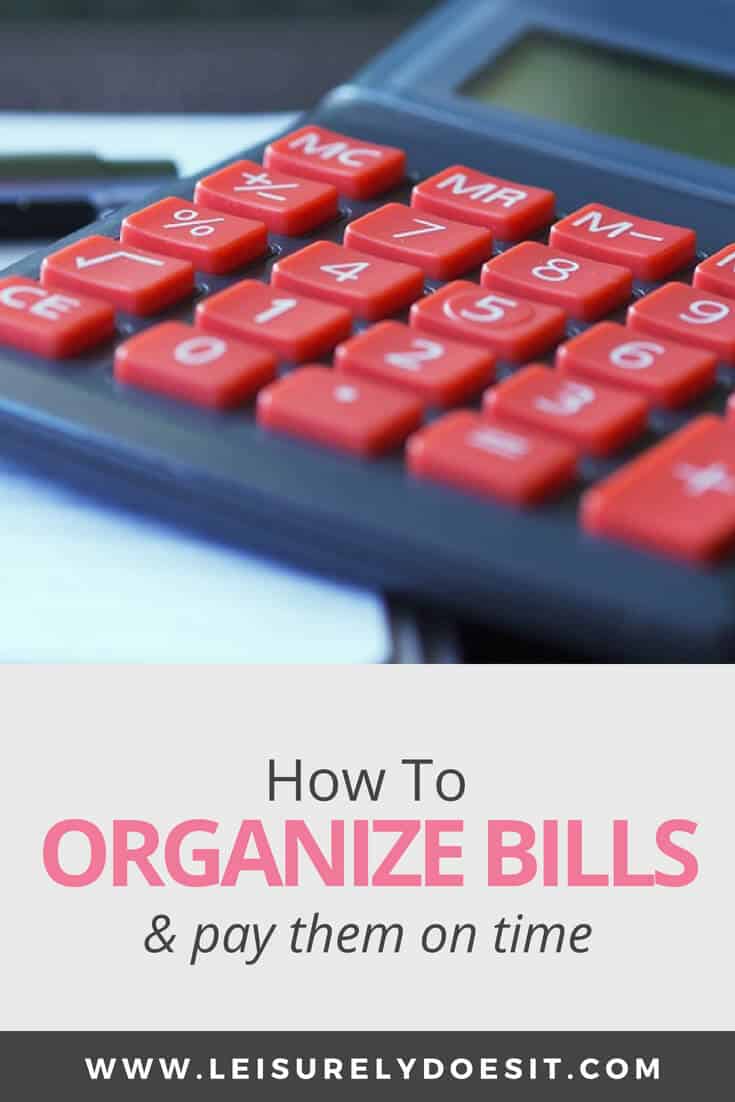
Organizing household bills is critical if you want to pay them on time. If you’ve ever missed a payment because you couldn’t find the bill or you swore you paid it already, then you know what I mean.
While paying bills is never fun for anyone, making sure you can easily find them and track when payments are due makes the whole process go a lot smoother. Missed payments incur fees and might result in a service being disconnected. No-one wants that. Ultimately, paying bills on time is the reason you want to organize them well.
I have a simple method that will allow you to track payment due dates and find bills easily when it comes time to pay them. It does not require expensive software and can be set up anywhere you pay your bills.
So, what is this incredible organization method?
It’s a binder for your household bills.
Revolutionary, I know! Hold on to your hats because I’m going to rock your bill-paying world by letting you in on how you can quickly create your own.
HOW TO CREATE A BINDER FOR HOUSEHOLD BILLS
This post contains affiliate links. If you click and make a purchase, there’s absolutely no extra cost to you. Read my full Disclosure Policy here.
WHAT YOU WILL NEED
In order to create your household bills binder, you’re going to need a few supplies. Gather all of them and get ready to get organized. I have included links to each recommended item for your convenience.
- A 3-ring binder: 3 or 4 inch will work well
- Dividers with labels
- 3-ring pencil case
- 3-hole paper punch: I really like this one
- Calculator
- Pens: a red pen, as well as black or blue
- Monthly bill calendar sheets
- Paper clips or bulldog clips (optional)
- Sheet protectors (optional)
HOW TO SET UP YOUR DIY ORGANIZER BILLS BINDER
Place the dividers in the binder and label each for the various categories of bills you usually receive e.g. water, electricity, cell phone and cable. Insert the calendar sheets at the beginning of the binder, as well as the 3-hole punch (if you have one with holes that fit your binder rings) and the pencil case with all the supplies.
Gather your bills in one place when you bring them into the house. Bill organizers like these make this easy. Schedule a time weekly to open each if you can’t get to them right away. It’s best to do this the same time every week so you get into the habit of doing this task at a particular time. Set a reminder in your phone, if you need to. I love using Google Calendar to schedule my time and for notifications.
When you open each bill, write down the payment due date and the amount on the appropriate calendar page. There are two options for what to do with the unpaid bills. You can either place them in the pocket at the front of the binder or create a divider labelled “Unpaid Bills” and place all of them there.
If you choose to place the unpaid bills, in the front pocket of the binder, use paper clips or bulldog clips to hold them in place. This way, you can be certain they won’t fall out of the pocket.

TRACKING AND PAYING YOUR BILLS
Determine what day(s) you will pay your household bills monthly. Again, try to do this the same time(s) each month so it becomes routine. As you pay each bill, use the red pen and write down the amount that you paid on the bill itself, along with the date of payment. If you pay your bills online, note the transaction number as well.
Cross off the specific bill on the corresponding calendar sheet. Afterwards, use the paper punch to pierce three holes in the bill and place it in the appropriate section of the binder. Feel free to use sheet protectors if you don’t want to punch holes in your bills.
At the end of the year, remove all of the documents and only keep those required for tax purposes. Place those items in a separate folder labelled with the year. This way it’s easy to find the bills later.

ORGANIZE BILLS ONLINE
I recognize that in this modern age, not everyone receives hard copies of bills anymore. You can still utilize a similar binder system to organize your bills.
You can use a digital calendar to track bill-related information but a physical calendar will be a nice visual aid. Print off the calendar sheets and fill them out the same way mentioned above. As you receive and pay your digital bills, write down all the necessary information.
Now you have several options:
- You can print out the bills to keep in the folder but this kind of defeats the purpose of receiving bills digitally anyway. Most people want to cut down on paper clutter.
- I usually create a folder in my email labelled with the category of bill. After the bill is paid, I store the email there.
- Alternatively, you can download the bills as a PDF and store them in an “Unpaid Bills” folder on your computer. Create a “Paid Bills” folder with sub-folders for each month inside. After each bill has been paid, move the file over to the appropriate month within the “Paid Bills” folder.
However you choose to organize your digital bills, at the end of the year, delete any files you no longer need.
Placing your bills in a binder—whether physical or digital—makes it really easy to track them. No more missed payments, lost bills or confusion over whether you already paid. This system is the best way to organize bills that I’ve found and if you choose to use it, you’ll be well on your way to becoming a bill-paying maven.
Did you enjoy this post? If so, don’t forget to share it on Pinterest!

